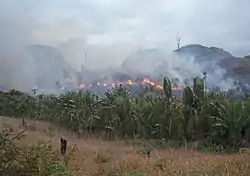Water scarcity
Water scarcity (water stress or water crisis) is the lack of fresh water resources to meet the standard water demand. Humanity is facing a water crisis, due to unequal distribution (exacerbated by climate change) resulting in some very wet and some very dry geographic locations, plus a sharp rise in global freshwater demand in recent decades driven by industry. Water scarcity can also be caused by droughts, lack of rainfall, or pollution. This was listed in 2019 by the World Economic Forum as one of the largest global risks in terms of potential impact over the next decade.[1] It is manifested by partial or no satisfaction of expressed demand, economic competition for water quantity or quality, disputes between users, irreversible depletion of groundwater, and negative impacts on the environment.[2] Two-thirds of the global population (4 billion people) live under conditions of severe water scarcity at least 1 month of the year.[3][4][5][6] Half a billion people in the world face severe water scarcity all year round.[3] Half of the world's largest cities experience water scarcity.[5]
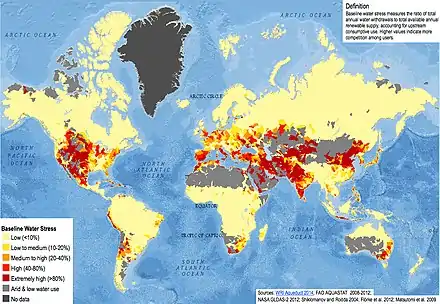
The essence of global water scarcity is the geographic and temporal mismatch between freshwater demand and availability.[7][8] The increasing world population, improving living standards, changing consumption patterns, and expansion of irrigated agriculture are the main driving forces for the rising global demand for water.[9][10] Climate change, such as altered weather-patterns (including droughts or floods), deforestation, increased pollution, green house gases, and wasteful use of water can cause insufficient supply.[11] At the global level and on an annual basis, enough freshwater is available to meet such demand, but spatial and temporal variations of water demand and availability are large, leading to (physical) water scarcity in several parts of the world during specific times of the year.[3] Scarcity varies over time as a result of natural hydrological variability, but varies even more so as a function of prevailing economic policy, planning and management approaches. Scarcity can be expected to intensify with most forms of economic development, but, if correctly identified, many of its causes can be predicted, avoided or mitigated.[2]
The International Resource Panel of the UN states that governments have tended to invest heavily in largely inefficient solutions: mega-projects like dams, canals, aqueducts, pipelines and water reservoirs, which are generally neither environmentally sustainable nor economically viable. The most cost-effective way of decoupling water use from economic growth, according to the scientific panel, is for governments to create holistic water management plans that take into account the entire water cycle: from source to distribution, economic use, treatment, recycling, reuse and return to the environment.[12]
Terminology
Physical water scarcity
Physical water scarcity is where there is not enough water to meet all demands, including that needed for ecosystems to function effectively. Arid regions frequently suffer from physical water scarcity. It also occurs where water seems abundant but where resources are over-committed, such as when there is overdevelopment of hydraulic infrastructure for irrigation. Symptoms of physical water scarcity include environmental degradation and declining groundwater. Water stress harms living things because every organism needs water to live.
Physical water scarcity results from inadequate natural water resources to supply a region's demand, and economic water scarcity results from poor management of the sufficient available water resources. According to the United Nations Development Programme, the latter is found more often to be the cause of countries or regions experiencing water scarcity, as most countries or regions have enough water to meet household, industrial, agricultural, and environmental needs, but lack the means to provide it in an accessible manner.[13] Around one-fifth of the world's population currently live in regions affected by Physical water scarcity, where there are inadequate water resources to meet a country's or regional demand, including the water needed to fulfill the demand of ecosystems to function effectively.[13] Arid regions frequently suffer from physical water scarcity. It also occurs where water seems abundant but where resources are over-committed, such as when there is overdevelopment of hydraulic infrastructure for irrigation. Symptoms of physical water scarcity include environmental degradation and declining groundwater as well as other forms of exploitation or overuse.[14]
Economic water scarcity
Economic water scarcity is caused by a lack of investment in infrastructure or technology to draw water from rivers, aquifers or other water sources, or insufficient human capacity to satisfy the demand for water. One-quarter of the world's population is affected by economic water scarcity. Economic water scarcity includes a lack of infrastructure, causing the people without reliable access to water to have to travel long distances to fetch water, which is often contaminated from rivers for domestic and agricultural uses.
Water crisis
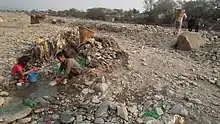
When there is not enough potable water for a given population, the threat of a water crisis is realized.[15] The United Nations and other world organizations consider a variety of regions to have water crises of global concern.[16][17] Other organizations, such as the Food and Agriculture Organization, argue that there are no water crises in such places, but steps must still be taken to avoid one.[18]
Water stress and indicators
Hydrologists today typically assess water scarcity by looking at the population-water equation. This is done by comparing the amount of total available water resources per year to the population of a country or region. A popular approach to measuring water scarcity has been to rank countries according to the amount of annual water resources available per person.
For example, according to the Falkenmark Water Stress Indicator,[19] a country or region is said to experience "water stress" when annual water supplies drop below 1,700 cubic metres per person per year. At levels between 1,700 and 1,000 cubic metres per person per year, periodic or limited water shortages can be expected. When water supplies drop below 1,000 cubic metres per person per year, the country faces "water scarcity".[20]
Others
Other ways of measuring water scarcity include examining the physical existence of water in nature, comparing nations with lower or higher volumes of water available for use. This method often fails to capture the accessibility of the water resource to the population that may need it. Others have related water availability to population.
Water resources


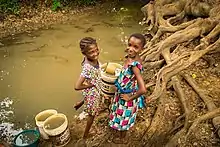

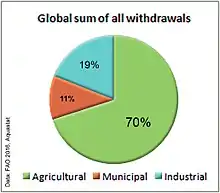

Availability
The United Nations (UN) estimates that, of 1.4 billion cubic kilometers (1 quadrillion acre-feet) of water on Earth, just 200,000 cubic kilometers (162.1 billion acre-feet) represent fresh water available for human consumption.[21] A mere 0.014% of all water on Earth is both fresh and easily accessible. Of the remaining water, 97% is saline and a little less than 3% is difficult to access. The total amount of easily accessible freshwater on Earth, in the form of surface water (rivers and lakes) or groundwater (in aquifers, for example), is 14,000 cubic kilometres (nearly 3359 cubic miles). Of this total amount, 'just' 5,000 cubic kilometres are being used and reused by humanity. Technically, there is a sufficient amount of freshwater on a global scale.
Hence, in theory, there is more than enough freshwater available to meet the demands of the current world population of more than 7 billion people, and even support population growth to 9 billion or more. Due to the unequal geographical distribution and especially the unequal consumption of water, however, it is a scarce resource in some parts of the world and for some parts of the population.[22]
Renewable freshwater resources
Renewable freshwater supply is a metric often used in conjunction when evaluating water scarcity. This metric is informative because it can describe the total available water resource each country contains. By knowing the total available water source, an idea can be gained about whether a country is prone to experiencing physical water scarcity. This metric has its faults in that it is an average; precipitation delivers water unevenly across the planet each year and annual renewable water resources vary from year to year. This metric also does not describe the accessibility of water to individuals, households, industries, or the government. Lastly, as this metric is a description of a whole country, it does not accurately portray whether a country is experiencing water scarcity. Canada and Brazil both have very high levels of available water supply, but still experience various water related problems.[23]
It can be observed that tropical countries in Asia and Africa have low availability of freshwater resources (see List of countries by total renewable water resources).
Demand
More than one in every six people in the world is water stressed, meaning that they do not have sufficient access to potable water.[13] Those that are water stressed make up 1.1 billion people in the world and are living in developing countries. In 2006, about 700 million people in 43 countries were living below the 1,700 cubic metres per person threshold.[13] Water stress is ever intensifying in regions such as China, India, and Sub-Saharan Africa, which contains the largest number of water stressed countries of any region with almost one fourth of the population living in a water stressed country.[13] The world's most water stressed region is the Middle East with averages of 1,200 cubic metres of water per person.[13] In China, more than 538 million people are living in a water-stressed region. Much of the water stressed population currently live in river basins where the usage of water resources greatly exceed the renewal of the water source.
Demand is expected to outstrip supply by 40% in 2030, if current trends continue.[5][22]
Causes and contributing factors
Depletion of freshwater resources
Apart from the conventional surface water sources of freshwater such as rivers and lakes, other resources of freshwater such as groundwater and glaciers have become more developed sources of freshwater, becoming the main source of clean water. Groundwater is water that has pooled below the surface of the Earth and can provide a usable quantity of water through springs or wells. These areas where groundwater is collected are also known as aquifers. Glaciers provide freshwater in the form meltwater, or freshwater melted from snow or ice, that supply streams or springs as temperatures rise. More and more of these sources are being drawn upon as conventional sources' usability decreases due to factors such as pollution or disappearance due to climate changes. Human population growth is a significant contributing factor in the increasing use of these types of water resources.[23]
Groundwater
Due to the expanding human population, competition for water is growing such that many of the world's major aquifers are becoming depleted. This is due both for direct human consumption as well as agricultural irrigation by groundwater. Millions of pumps of all sizes are currently extracting groundwater throughout the world. Irrigation in dry areas such as northern China, Nepal and India is supplied by groundwater, and is being extracted at an unsustainable rate. Cities that have experienced aquifer drops between 10 and 50 meters include Mexico City, Bangkok, Beijing, Madras and Shanghai.[25]
Until recent history, groundwater was not a highly utilized resource. In the 1960s, more and more groundwater aquifers developed.[26] Changes in knowledge, technology and funding have allowed for focused development into abstracting water from groundwater resources away from surface water resources. These changes allowed for progress in society such as the "agricultural groundwater revolution", expanding the irrigation sector allowing for increased food production and development in rural areas.[27] Groundwater supplies nearly half of all drinking water in the world.[28] The large volumes of water stored underground in most aquifers have a considerable buffer capacity allowing for water to be withdrawn during periods of drought or little rainfall.[23] This is crucial for people that live in regions that cannot depend on precipitation or surface water as a supply alone, instead providing reliable access to water all year round. As of 2010, the world's aggregated groundwater abstraction is estimated at approximately 1,000 km3 per year, with 67% used for irrigation, 22% used for domestic purposes and 11% used for industrial purposes.[23] The top ten major consumers of abstracted water (India, China, United States of America, Pakistan, Iran, Bangladesh, Mexico, Saudi Arabia, Indonesia, and Italy) make up 72% of all abstracted water use worldwide.[23] Groundwater has become crucial for the livelihoods and food security of 1.2 to 1.5 billion rural households in the poorer regions of Africa and Asia.[29]
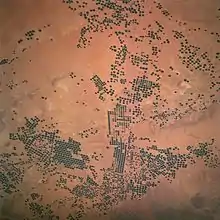
Although groundwater sources are quite prevalent, one major area of concern is the renewal rate or recharge rate of some groundwater sources. Extracting from groundwater sources that are non-renewable could lead to exhaustion if not properly monitored and managed.[31] Another concern of increased groundwater usage is the diminished water quality of the source over time. Reduction of natural outflows, decreasing stored volumes, declining water levels and water degradation are commonly observed in groundwater systems.[23] Groundwater depletion may result in many negative effects such as increased cost of groundwater pumping, induced salinity and other water quality changes, land subsidence, degraded springs and reduced baseflows. Human pollution is also harmful to this important resource.
To set up a big plant near a water abundant area, bottled water companies need to extract groundwater from a source at a rate more than the replenishment rate leading to the persistent decline in the groundwater levels. The groundwater is taken out, bottled, and then shipped all over the country or world and this water never goes back. When the water table depletes beyond a critical limit, bottling companies just move from that area leaving a grave water scarcity. Groundwater depletion impacts everyone and everything in the area that uses the water: farmers, businesses, animals, ecosystems, tourism and other users e.g. people reliant on a local well for potable water. Millions of gallons of water out of the ground leaves the water table depleted uniformly and not just in that area because the water table is connected across the landmass. Bottling Plants generate water scarcity and impact ecological balance. They lead to water stressed areas which bring in droughts.[32]
Glaciers
Glaciers are noted as a vital water source due to their contribution to stream flow. Rising global temperatures have noticeable effects on the rate at which glaciers melt, causing glaciers in general to shrink worldwide.[33] Although the meltwater from these glaciers is increasing the total water supply for the present, the disappearance of glaciers in the long term will diminish available water resources. Increased meltwater due to rising global temperatures can also have negative effects such as flooding of lakes and dams and globally catastrophic results.[34]
Expansion of agricultural and industrial users
Scarcity as a result of consumption is caused primarily by the extensive use of water in agriculture/livestock breeding and industry. People in developed countries generally use about 10 times more water daily than those in developing countries.[35] A large part of this is indirect use in water-intensive agricultural and industrial production processes of consumer goods, such as fruit, oilseed crops and cotton. Because many of these production chains have been globalized, a lot of water in developing countries is being used and polluted in order to produce goods destined for consumption in developed countries.[22]
Business activity ranging from industrialization to services such as tourism and entertainment continues to expand rapidly. This expansion requires increased water services including both supply and sanitation, which can lead to more pressure on water resources and natural ecosystem.
Climate change
Climate change could have significant impacts on water resources around the world because of the close connections between the climate and hydrological cycle. Rising temperatures will increase evaporation and lead to increases in precipitation, though there will be regional variations in rainfall. Both droughts and floods may become more frequent in different regions at different times, and dramatic changes in snowfall and snow melt are expected in mountainous areas. Higher temperatures will also affect water quality in ways that are not well understood. Possible impacts include increased eutrophication. Climate change could also mean an increase in demand for farm irrigation, garden sprinklers, and perhaps even swimming pools. There is now ample evidence that increased hydrologic variability and change in climate has and will continue have a profound impact on the water sector through the hydrologic cycle, water availability, water demand, and water allocation at the global, regional, basin, and local levels.[36]
The United Nations' FAO states that by 2025, 1.9 billion people will live in countries or regions with absolute water scarcity, and two-thirds of the world population could be under stress conditions.[37] The World Bank adds that climate change could profoundly alter future patterns of both water availability and use, thereby increasing levels of water stress and insecurity, both at the global scale and in sectors that depend on water.[38]
Another popular opinion is that the amount of available freshwater is decreasing because of climate change. Climate change has caused receding glaciers, reduced stream and river flow, and shrinking lakes and ponds. Many aquifers have been over-pumped and are not recharging quickly. Although the total fresh water supply is not used up, much has become polluted, salted, unsuitable or otherwise unavailable for drinking, industry and agriculture. To avoid a global water crisis, farmers will have to strive to increase productivity to meet growing demands for food, while industry and cities find ways to use water more efficiently.[39]
A New York Times article, "Southeast Drought Study Ties Water Shortage to Population, Not Global Warming", summarizes the findings of Columbia University researcher on the subject of the droughts in the American Southeast between 2005 and 2007. The findings published in the Journal of Climate say that the water shortages resulted from population size more than rainfall. Census figures show that Georgia's population rose from 6.48 to 9.54 million between 1990 and 2007.[40] After studying data from weather instruments, computer models, and tree ring measurements, they found that the droughts were not unprecedented and result from normal climate patterns and random weather events. "Similar droughts unfolded over the last thousand years", the researchers wrote, "Regardless of climate change, they added, similar weather patterns can be expected regularly in the future, with similar results."[40] As the temperature increases, rainfall in the Southeast will increase but because of evaporation the area may get even drier. The researchers concluded with a statement saying that any rainfall comes from complicated internal processes in the atmosphere and are very hard to predict because of the large amount of variables.

Population growth
Around fifty years ago, the common perception was that water was an infinite resource. At that time, there were fewer than half the current number of people on the planet. People were not as wealthy as today, consumed fewer calories and ate less meat, so less water was needed to produce their food. They required a third of the volume of water we presently take from rivers. Today, the competition for water resources is much more intense. This is because there are now seven billion people on the planet, their consumption of water-thirsty meat is rising, and there is increasing competition for water from industry, urbanisation biofuel crops, and water reliant food items. In the future, even more water will be needed to produce food because the Earth's population is forecast to rise to 9 billion by 2050.[42]
In 2000, the world population was 6.2 billion. The UN estimates that by 2050 there will be an additional 3.5 billion people with most of the growth in developing countries that already suffer water stress.[43] Thus, water demand will increase unless there are corresponding increases in water conservation and recycling of this vital resource.[44] In building on the data presented here by the UN, the World Bank[45] goes on to explain that access to water for producing food will be one of the main challenges in the decades to come. Access to water will need to be balanced with the importance of managing water itself in a sustainable way while taking into account the impact of climate change, and other environmental and social variables.[46]
Rapid urbanization
The trend towards urbanization is accelerating. Small private wells and septic tanks that work well in low-density communities are not feasible within high-density urban areas. Urbanization requires significant investment in water infrastructure in order to deliver water to individuals and to process the concentrations of wastewater – both from individuals and from business. These polluted and contaminated waters must be treated or they pose unacceptable public health risks.
In 60% of European cities with more than 100,000 people, groundwater is being used at a faster rate than it can be replenished.[47] Even if some water remains available, it costs increasingly more to capture it.
Impacts
There are several principal manifestations of the water crisis.
- Food security in the Middle East and North Africa Region [48][49]
- Inadequate access to safe drinking water for about 885 million people[50]
- Inadequate access to sanitation for 2.5 billion people,[51] which often leads to water pollution
- Groundwater overdrafting (excessive use) leading to diminished agricultural yields[52]
- Overuse and pollution of water resources harming biodiversity
- Regional conflicts over scarce water resources sometimes resulting in warfare .[53]
Environment
Water scarcity has many negative impacts on the environment, such as adverse effects on lakes, rivers, ponds, wetlands and other fresh water resources. The resulting water overuse that is related to water scarcity, often located in areas of irrigation agriculture, harms the environment in several ways including increased salinity, nutrient pollution, and the loss of floodplains and wetlands.[13][54] Furthermore, water scarcity makes flow management in the rehabilitation of urban streams problematic.[55]
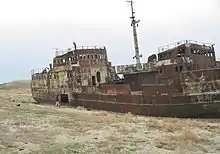
Through the last hundred years, more than half of the Earth's wetlands have been destroyed and have disappeared.[11] These wetlands are important not only because they are the habitats of numerous inhabitants such as mammals, birds, fish, amphibians, and invertebrates, but they support the growing of rice and other food crops as well as provide water filtration and protection from storms and flooding. Freshwater lakes such as the Aral Sea in central Asia have also suffered. Once the fourth largest freshwater lake, it has lost more than 58,000 square km of area and vastly increased in salt concentration over the span of three decades.[11]
Subsidence, or the gradual sinking of landforms, is another result of water scarcity. The U.S. Geological Survey estimates that subsidence has affected more than 17,000 square miles in 45 U.S. states, 80 percent of it due to groundwater usage. In some areas east of Houston, Texas the land has dropped by more than nine feet due to subsidence.[56] Brownwood, a subdivision near Baytown, Texas, was abandoned due to frequent flooding caused by subsidence and has since become part of the Baytown Nature Center.
Vegetation and wildlife are fundamentally dependent upon adequate freshwater resources. Marshes, bogs and riparian zones are more obviously dependent upon sustainable water supply, but forests and other upland ecosystems are equally at risk of significant productivity changes as water availability is diminished. In the case of wetlands, considerable area has been simply taken from wildlife use to feed and house the expanding human population. But other areas have suffered reduced productivity from gradual diminishing of freshwater inflow, as upstream sources are diverted for human use. In seven states of the U.S. over 80 percent of all historic wetlands were filled by the 1980s, when Congress acted to create a "no net loss" of wetlands.
In Europe extensive loss of wetlands has also occurred with resulting loss of biodiversity. For example, many bogs in Scotland have been developed or diminished through human population expansion. One example is the Portlethen Moss in Aberdeenshire.
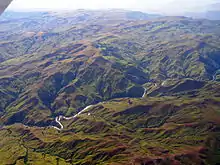
On Madagascar's highland plateau, a massive transformation occurred that eliminated virtually all the heavily forested vegetation in the period 1970 to 2000. The slash and burn agriculture eliminated about ten percent of the total country's native biomass and converted it to a barren wasteland. These effects were from overpopulation and the necessity to feed poor indigenous peoples, but the adverse effects included widespread gully erosion that in turn produced heavily silted rivers that "run red" decades after the deforestation. This eliminated a large amount of usable fresh water and also destroyed much of the riverine ecosystems of several large west-flowing rivers. Several fish species have been driven to the edge of extinction and some, such as the disturbed Tokios coral reef formations in the Indian Ocean, are effectively lost. In October 2008, Peter Brabeck-Letmathe, chairman and former chief executive of Nestlé, warned that the production of biofuels will further deplete the world's water supply.
Water shortages
Waterborne diseases caused by lack of sanitation and hygiene are one of the leading causes of death worldwide. For children under age five, waterborne diseases are a leading cause of death. According to the World Bank, 88 percent of all waterborne diseases are caused by unsafe drinking water, inadequate sanitation and poor hygiene.[57]
Water is the underlying tenuous balance of safe water supply, but controllable factors such as the management and distribution of the water supply itself contribute to further scarcity.
A 2006 United Nations report focuses on issues of governance as the core of the water crisis, saying "There is enough water for everyone" and "Water insufficiency is often due to mismanagement, corruption, lack of appropriate institutions, bureaucratic inertia and a shortage of investment in both human capacity and physical infrastructure".[58] Official data also shows a clear correlation between access to safe water and GDP per capita.[59]
It has also been claimed, primarily by economists, that the water situation has occurred because of a lack of property rights, government regulations and subsidies in the water sector, causing prices to be too low and consumption too high, making a point for water privatization.[60][61][62]
Approaches
Cooperation
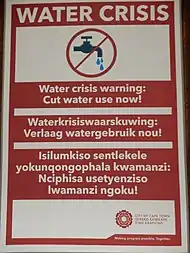
It is alleged that the likelihood of conflict rises if the rate of change within a basin exceeds the capacity of institutions to absorb that change.[63] Although water crises can relate closely to regional tensions, history has shown that cases of cooperation far outnumber acute conflicts over water.
However, lack of cooperation may give rise to regional conflicts in many parts of the world, specially in developing countries, largely because of the disputes regarding the availability, use and management of water.[53] For example, the dispute between Egypt and Ethiopia over the Grand Ethiopian Renaissance Dam has escalated in 2020.[64][65] Egypt sees the dam as an existential threat, fearing that the dam will reduce the amount of water it receives from the Nile.[66]
The Indus River Commission and the 1960 Indus Water Treaty have survived two wars between India and Pakistan despite the two countries' mutual hostility, proving a successful mechanism in resolving conflicts by providing a framework for consultation, inspection and exchange of data. The Mekong Committee has functioned since 1957 and outlived the Vietnam War of 1955–1975. In contrast, regional instability results when countries lack institutions to co-operate in regional collaboration, like Egypt's plan for a high dam on the Nile. However, as of 2019 no global institution supervises the management of trans-boundary water sources, and international co-operation has happened through ad hoc collaboration between agencies, like the Mekong Committee which formed due to an alliance between UNICEF and the US Bureau of Reclamation. Formation of strong international institutions seems to provide a way forward – they encourage early intervention and management, avoiding costly dispute-resolution processes.
One common feature of almost all resolved disputes is that the negotiations had a "need-based" instead of a "right–based" paradigm. Irrigable lands, population, and technicalities of projects define "needs". The success of a need-based paradigm is reflected in the only water agreement ever negotiated in the Jordan River Basin, which focuses in needs not on rights of riparians. In the Indian subcontinent, the irrigation requirements of Bangladesh determine water allocations of the Ganges River. A need-based, regional approach focuses on satisfying individuals with their need of water, ensuring that minimum quantitative needs are met. It removes the conflict that arises when countries view the treaty from a national-interest point-of-view and move away from a zero-sum approach to a positive-sum, integrative approach that equitably allocates water and its benefits.
The Blue Peace framework developed by Strategic Foresight Group in partnership with the governments of Switzerland and Sweden offers a unique policy structure which promotes sustainable management of water resources combined with cooperation for peace. By making the most of shared water-resources through cooperation rather than mere allocation between countries, the chances for peace can increase.[67] The Blue Peace approach has proven effective in (for example) the Middle East[68][69] and the Nile basin.[70][71] NGOs like Water.org, There Is No Limit Foundation,[72] and Charity: Water are leading the way in providing access to clean water.

Water production and conservation
The solutions for the various national water crisis are partly (fresh)water protection and production with different technologies.
Solar humidification and dehumidification
Many atmospheric water generators operate in a manner very similar to that of a dehumidifier: air is passed over a cooled coil, causing water to condense.[73] Some of its advantages are their low price, the absence of heavy metals and bacteria improving populations health and their versatility of use of air as source of water, without the need of a lake, river or ocean nearby.
Clean water technology
The treatment of wastewater helps to protect natural waterbodies and has started to become a source of drinking water in places like Singapore.
Desalination machines are designed to extract mineral components from saline water. More generally, desalination refers to the removal of salts and minerals from a target substance,[74] Energy efficient desalination with an electricity use of less than 1,0 kwh per cubic metre of freshwater can be regarded as the end to the global water crisis. Several companies have developed technologies under this value like Siemens and TS Prototype-Creation. 1,0 kwh is little more than that required for pumping of water in the national grit in Germany. The IBTS Greenhouse, designed for water desalination produces distilled water with 0,45 kwh per cubic metre.
Together, wastewater treament and desalination have the potential to strongly reduce the number of people affected by water scarcity globally. However, economic and environmental side effects of these technologies must also be taken into consideration.[75]
Regional examples
Overview of regions
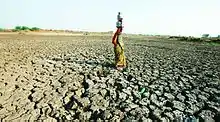

There are many countries of the world that are severely impacted with regard to human health and inadequate drinking water. The following is a partial list of some of the countries with significant populations (numerical population of affected population listed) whose only consumption is of contaminated water:[76]
- Sudan (12.3 million)
- Venezuela (5.0 million)
- Ethiopia (2.7 million)
- Tunisia (2.1 million)
- Cuba (1.3 million)
Several world maps showing various aspects of the problem can be found in this graph article.[77]
The following countries have large water deficits — Algeria, Egypt, Iran, Mexico, and Pakistan.
Water deficits, which are already spurring heavy grain imports in numerous smaller countries, may soon do the same in larger countries, such as China and India.[78] The water tables are falling in scores of countries (including Northern China, the US, and India) due to widespread over-pumping using powerful diesel and electric pumps. Other countries affected include Pakistan, Iran, and Mexico. This will eventually lead to water scarcity and cutbacks in grain harvest.
In 2025, water shortages will be more prevalent among poorer countries where resources are limited and population growth is rapid, such as the Middle East, Africa, and parts of Asia. By 2025, large urban and peri-urban areas will require new infrastructure to provide safe water and adequate sanitation. This suggests growing conflicts with agricultural water users, who currently consume the majority of the water used by humans.
Generally speaking the more developed countries of North America, Europe and Russia will not see a serious threat to water supply by the year 2025, not only because of their relative wealth, but more importantly their populations will be better aligned with available water resources. North Africa, the Middle East, South Africa and northern China will face very severe water shortages due to physical scarcity and a condition of overpopulation relative to their carrying capacity with respect to water supply. Most of South America, Sub-Saharan Africa, Southern China and India will face water supply shortages by 2025; for these latter regions the causes of scarcity will be economic constraints to developing safe drinking water, as well as excessive population growth.
West Africa and North Africa
Water scarcity in Yemen (see: Water supply and sanitation in Yemen) is a growing problem that has resulted from population growth, poor water management, climate change, shifts in rainfall, water infrastructure deterioration, poor governance, and other anthropogenic effects. As of 2011, it has been estimated that Yemen is experiencing water scarcity to a degree that affects its political, economic and social dimensions. As of 2015,[79] Yemen is among the most water scarce countries in the world. The majority of Yemen's population experiences water scarcity for at least one month during the year. In Nigeria, some reports have suggested that increase in extreme heat, drought and the shrinking of Lake Chad is causing water shortage and environmental migration that is forcing thousands to migrate to neighbouring Chad and towns.[80]
Asia
According to a major report compiled in 2019 by more than 200 researchers, the Himalayan glaciers that are the sources of Asia's biggest rivers – Ganges, Indus, Brahmaputra, Yangtze, Mekong, Salween and Yellow – could lose 66 percent of their ice by 2100.[81] Approximately 2.4 billion people live in the drainage basin of the Himalayan rivers.[82] India, China, Pakistan, Bangladesh, Nepal and Myanmar could experience floods followed by droughts in coming decades. In India alone, the Ganges provides water for drinking and farming for more than 500 million people.[83][84][85]
Even with the overpumping of its aquifers, China is developing a grain deficit. When this happens, it will almost certainly drive grain prices upward. Most of the 3 billion people projected to be added worldwide by mid-century will be born in countries already experiencing water shortages. Unless population growth can be slowed quickly, it is feared that there may not be a practical non-violent or humane solution to the emerging world water shortage.[86][87]
Americas
In the Rio Grande Valley, intensive agribusiness has exacerbated water scarcity issues and sparked jurisdictional disputes regarding water rights on both sides of the U.S.-Mexico border. Scholars, including Mexican political scientist Armand Peschard-Sverdrup, have argued that this tension has created the need for a re-developed strategic transnational water management.[88] Some have declared the disputes tantamount to a "war" over diminishing natural resources.[89][90]
The west coast of North America, which gets much of its water from glaciers in mountain ranges such as the Rocky Mountains and Sierra Nevada, also would be affected.[63][91]
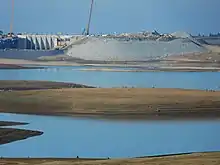
Australia
By far the largest part of Australia is desert or semi-arid lands commonly known as the outback.[93] Water restrictions are in place in many regions and cities of Australia in response to chronic shortages resulting from drought. The Australian of the year 2007, environmentalist Tim Flannery, predicted that unless it made drastic changes, Perth in Western Australia could become the world’s first ghost metropolis, an abandoned city with no more water to sustain its population.[94] In 2010, Perth suffered its second-driest winter on record[95] and the water corporation tightened water restrictions for spring.[96]
Some countries have already proven that decoupling water use from economic growth is possible. For example, in Australia, water consumption declined by 40% between 2001 and 2009 while the economy grew by more than 30%.[12]
Africa
Large parts of Africa suffer from economic water scarcity; developing water infrastructure in those areas could, therefore, help to reduce poverty. Critical conditions often arise for economically poor and politically weak communities living in an already dry environment. Consumption increases with GDP per capita: in most developed countries the average amount is around 200–300 liters daily. In developing countries (e.g. African countries such as Mozambique), average daily water consumption per capita was below 10 L. This is against the backdrop of international organizations, which recommend a minimum of 20 L of water (not including the water needed for washing clothes), available at most 1 km from the household. Increased water consumption is correlated with increasing income, as measured by GDP per capita. In countries suffering from water shortages water is the subject of speculation.[97]
Some countries in Africa have attempted to address issues with water scarcity by instituting a water permit system.[98] Under such a system, local rules are used to grant users access to a certain amount of water at certain locations.[99] However, such systems sometimes result in additional issues, as water rights can be monopolized by large-scale irrigators at the expense of smallholder farmers in the region.[100]
Another city facing a water crisis is Cape Town, South Africa. The government and scientists in the area were preparing for "day zero", meaning that the area was almost completely out of water.The government was hopeful that voluntary conservation efforts and environmental factors would increase the water supply in the reservoirs, but these things did not happen which increased the likelihood of the city running out of potable water. Scientists at the University of Cape Town are concerned because without a water source they are not able to conduct valuable medical research or clinical studies.[101] Day Zero was avoided and restrictions were lifted for residents, but conservation efforts are still in place with uncertainty in rainfall amounts.[102]
Society and culture
Human right to water

The United Nations Committee on Economic, Social and Cultural Rights established a foundation of five core attributes for water security. They declare that the human right to water entitles everyone to sufficient, safe, acceptable, physically accessible, and affordable water for personal and domestic use.[13]
Sustainable Development Goals
Sustainable Development Goal 6 is about "clean water and sanitation for all." It is one of 17 Sustainable Development Goals established by the United Nations General Assembly in 2015. Its official wording is: "Ensure availability and sustainable management of water and sanitation for all."[105] The goal has eight targets to be achieved by at least 2030. Progress toward the targets will be measured by using eleven indicators.[106] The Sustainable Development Goals replaced the Millennium Development Goals in 2016.
The full title of Target 6.1 is: "By 2030, achieve universal and equitable access to safe and affordable drinking water for all".[107] The full title of Target 6.2 is: "By 2030, achieve access to adequate and equitable sanitation and hygiene for all and end open defecation, paying special attention to the needs of women and girls and those in vulnerable situations."[108]
See also
Water scarcity in particular regions or countries:
- Water scarcity in Africa
- Water scarcity in Australia
- Water scarcity in Beijing
- Water scarcity in India
- Water scarcity in Iran
- Water scarcity in Mexico
- Water scarcity in the Middle East
Water crisis and water wars in particular locations:
References
- "Global risks report 2019". World Economic Forum. Retrieved 25 March 2019.
- "Coping with water scarcity. An action framework for agriculture and food stress" (PDF). Food and Agriculture Organization of the United Nations. 2012. Retrieved 31 December 2017.
- Hoekstra, A.Y.; Mekonnen, M.M. (12 February 2016). "Four billion people facing severe water scarcity" (PDF). advances.sciencemag. American Association for the Advancement of Science. Retrieved 30 December 2017.
- "4 billion people face water shortages, scientists find". World Economic Forum. 17 February 2016. Retrieved 30 December 2017.
- "How do we prevent today's water crisis becoming tomorrow's catastrophe?". World Economic Forum. 23 March 2017. Retrieved 30 December 2017.
- "Global Water Shortage Risk Is Worse Than Scientists Thought". Huffingtonpost.com. 15 February 2016. Retrieved 29 December 2017.
- S. L. Postel, G. C. Daily, P. R. Ehrlich, Human appropriation of renewable fresh water. Science 271, 785–788 (1996).
- H. H. G. Savenije, Water scarcity indicators; the deception of the numbers. Physics and Chemistry of the Earth B 25, 199–204 (2000).
- C. J. Vörösmarty, P. Green, J. Salisbury, R. B. Lammers, Global water resources: Vulnerability from climate change and population growth. Science 289, 284–288 (2000)
- A. E. Ercin, A. Y. Hoekstra, Water footprint scenarios for 2050: A global analysis. Environment International 64, 71–82 (2014).
- "Water Scarcity. Threats". WWF. 2013. Retrieved 20 October 2013.
- "Half the world to face severe water stress by 2030 unless water use is "decoupled" from economic growth, says International Resource Panel". UN Environment. 21 March 2016. Retrieved 11 January 2018.
- United Nations Development Programme (2006). Human Development Report 2006: Beyond Scarcity–Power, Poverty and the Global Water Crisis. Basingstoke, United Kingdom:Palgrave Macmillan.
- "Water scarcity, risk and vulnerability" (PDF). Retrieved 2 December 2014.
- Freshwater: lifeblood of the planet. Peopleandplanet.net (11 November 2002). Retrieved on 27 August 2013.
- "World water crisis worsened by corruption, repression: UN report". Un.org. 20 February 2006. Retrieved 10 March 2011.
- UN World Summit on Sustainable Development. Released by NRDC at the World Summit for Sustainable Development, 29 August 2002.
- "No global water crisis – but may developing countries will face water scarcity". FAO.org. 12 March 2003.
- Falkenmark and Lindh 1976, quoted in UNEP/WMO. "Climate Change 2001: Working Group II: Impacts, Adaptation and Vulnerability". UNEP. Archived from the original on 26 June 2015. Retrieved 3 February 2009.
- Larsen, Samuel T. L. "Lack of Freshwater Throughout the World". Evergreen State College. Retrieved 1 February 2009.
- Texas Water Report: Going Deeper for the Solution. Texas Comptroller of Public Accounts.
- "Water, bron van ontwikkeling, macht en conflict" (PDF). NCDO, Netherlands. 8 January 2012. Retrieved 1 January 2018.
- WWAP (World Water Assessment Programme). 2012. The United Nations World Water Development Report 4: Managing Water under Uncertainty and Risk. Paris, UNESCO.
- "Lake Chad: Can the vanishing lake be saved?". BBC News. 31 March 2018.
- "Groundwater in Urban Development". Wds.worldbank.org. 31 March 1998. p. 1. Retrieved 12 March 2009.
- unesdoc.unesco.org https://unesdoc.unesco.org/ark:/48223/pf0000134433. Retrieved 18 September 2020. Missing or empty
|title=(help) - Giordano, M. and Volholth, K. (ed.) 2007. The Agricultural Groundwater Revolution. Wallingford, UK, Centre for Agricultural Bioscience International (CABI).
- WWAP (World Water Assessment Programme). 2009. Water in a Changing World. World Water Development Report 3. Paris/London, UNESCO Publishing/Earthscan.
- Comprehensive Assessment of Water Management in Agriculture. 2007. Water for Food, Water for Life: A Comprehensive Assessment of Water Management in Agriculture. London/Colomb, Earthscan/International Water Management Institute
- "What California can learn from Saudi Arabia's water mystery". Reveal. 22 April 2015.
- Foster, S. and Loucks, D. 2006. Non-renewable Groundwater Resources. UNESCO-IHP Groundwater series No. 10. Paris, UNESCO.
- Gasson, Christopher. "Don't waste a drop". www.globalwaterintel.com. Mining Magazine. Retrieved 30 August 2018.
- Hewitt, K. 2005. The Karakoram Anomaly? Glacier expansion and the ‘elevation effect’, Karakoram Himalaya. Mountain Research and Development, Vol. 25, No. 4, pp. 332–40
- Hewitt, K., 1982. Natural Dams and Outburst Floods of the Karakoram Himalaya. Proceedings of the Symposium on Hydrological Aspects of Alpine and High Mountain Areas. International Association of Hydrological Sciences (IAHS) Publication No. 138. Wallingford, UK, IAHS Press.
- "Why freshwater shortages will cause the next great global crisis". The Guardian. 8 March 2015. Retrieved 3 January 2018.
- "Water and Climate Change: Understanding the Risks and Making Climate-Smart Investment Decisions". World Bank. 2009. Retrieved 24 October 2011.
- FAO Hot issues: Water scarcity. Fao.org. Retrieved on 27 August 2013.
- The World Bank, 2009 "Water and Climate Change: Understanding the Risks and Making Climate-Smart Investment Decisions". pp. 21–24. Retrieved 24 October 2011.
- Chartres, C. and Varma, S. Out of water. From Abundance to Scarcity and How to Solve the World’s Water Problems FT Press (USA), 2010
- Dean, Cornelia (2 October 2009) Southeast Drought Study Ties Water Shortage to Population, Not Global Warming. NY Times.
- "GEO-2000 overview overview" (PDF). unep.org. Retrieved 22 September 2016.
- United Nations Press Release POP/952, 13 March 2007. World population will increase by 2.5 billion by 2050
- "World population to reach 9.1 billion in 2050, UN projects". Un.org. 24 February 2005. Retrieved 12 March 2009.
- Foster, S. S.; Chilton, P. J. (29 December 2003). "Groundwater – the processes and global significance of aquifer degradation". Philosophical Transactions of the Royal Society of London. Series B, Biological Sciences. 358 (1440): 1957–1972. doi:10.1098/rstb.2003.1380. PMC 1693287. PMID 14728791.
- "Water". World Bank.
- "Sustaining water for all in a changing climate: World Bank Group Implementation Progress Report". The World Bank. 2010. Retrieved 24 October 2011.
- "Europe's Environment: The Dobris Assessment". Reports.eea.europa.eu. 20 May 1995. Retrieved 12 March 2009.
- Nouri, H.; Stokvis, B.; Galindo, A.; Blatchford, M.; Hoekstra, A.Y. (2019). "Water scarcity alleviation through water footprint reduction in agriculture: The effect of soil mulching and drip irrigation". Science of the Total Environment. 653: 241–252. Bibcode:2019ScTEn.653..241N. doi:10.1016/j.scitotenv.2018.10.311. PMID 30412869.
- Barnes, Jessica (Fall 2020). "Water in the Middle East: A Primer" (PDF). Middle East Report. 296: 1–9 – via Middle East Research and Information Project (MERIP).
- Progress in Drinking-water and Sanitation: special focus on sanitation (PDF). MDG Assessment Report 2008. WHO/UNICEF Joint Monitoring Programme for Water Supply and Sanitation. 17 July 2008. p. 25.
- "Updated Numbers: WHO-UNICEF JMP Report 2008". Unicef.org. Retrieved 10 March 2011.
- "Water is Life – Groundwater drawdown". Academic.evergreen.edu. Retrieved 10 March 2011.
- "The Coming Wars for Water". Report Syndication. 12 October 2019.
- "Water Scarcity Index – Vital Water Graphics". Retrieved 20 October 2013.
- J.E. Lawrence; C.P.W. Pavia; S. Kaing; H.N. Bischel; R.G. Luthy; V.H. Resh (2014). "Recycled Water for Augmenting Urban Streams in Mediterranean-climate Regions: A Potential Approach for Riparian Ecosystem Enhancement". Hydrological Sciences Journal. 59 (3–4): 488–501. doi:10.1080/02626667.2013.818221. S2CID 129362661.
- Texas Water Report: Going Deeper for the Solution Texas Comptroller of Public Accounts. Retrieved 2/10/14.
- "All About: Water and Health". CNN. 18 December 2007.
- Water, a shared responsibility. The United Nations World Water Development Report 2, 2006
- "Public Services". Gapminder video.
- Segerfeldt, Fredrik (25 August 2005), "Private Water Saves Lives", Financial Times.
- Zetland, David (1 August 2008) "Running Out of Water". aguanomics.com
- Zetland, David (14 July 2008) "Water Crisis". aguanomics.com
- "Glaciers Are Melting Faster Than Expected, UN Reports". Sciencedaily.com. 18 March 2008. Retrieved 10 March 2011.
- Walsh, Decian (9 February 2020). "For Thousands of Years, Egypt Controlled the Nile. A New Dam Threatens That". New York Times. Archived from the original on 10 February 2020.
- "Are Egypt and Ethiopia heading for a water war?". The Week. 8 July 2020.
- "Row over Africa's largest dam in danger of escalating, warn scientists". Nature. 15 July 2020.
- Turkish Review, March 2013
- "Strategic Foresight Group - Anticipating and Influencing Global Future" (PDF). www.strategicforesight.com.
- eda.base.components.templates.base.accessKeys. Deza.admin.ch. Retrieved on 2015-11-24.
- "Strategic Foresight Group - Anticipating and Influencing Global Future" (PDF). www.strategicforesight.com.
- "Blue Peace: New Solution for Averting Water Wars in the Nile Basin - Yahoo Finance". 28 September 2013. Archived from the original on 28 September 2013.
- "There Is No Limit Foundation". www.thereisnolimitfoundation.org.
- Environmental Assessment of Air to Water Machines. International Journal of Life Cycle Assessment, 18:1149-1157.
- "Desalination" (definition), The American Heritage Science Dictionary, via dictionary.com. Retrieved August 19, 2007.
- van Vliet, Michelle T H; Jones, Edward R; Flörke, Martina; Franssen, Wietse H P; Hanasaki, Naota; Wada, Yoshihide; Yearsley, John R (1 February 2021). "Global water scarcity including surface water quality and expansions of clean water technologies". Environmental Research Letters. 16 (2): 024020. doi:10.1088/1748-9326/abbfc3. ISSN 1748-9326.
- Safe Drinking Water. WHO/UNICEF Joint Monitoring Programme, 2001.
- Chenoweth, Jonathan (28 August 2008) "Looming water crisis simply a management problem". New Scientist, pp. 28–32.
- "India grows a grain crisis". Atimes.com. 21 July 2006. Retrieved 10 March 2011.
- https://www.atlanticcouncil.org/blogs/menasource/running-out-of-water-conflict-and-water-scarcity-in-yemen-and-syria/
- "The Carbon Brief Profile: Nigeria".
- "Himalayan glaciers melting at alarming rate, spy satellites show". National Geographic. 19 June 2019.
- Big melt threatens millions, says UN. peopleandplanet.net. 4 June 2007
- "Ganges, Indus may not survive: climatologists". Rediff.com. 31 December 2004. Retrieved 10 March 2011.
- "Glaciers melting at alarming speed". English.peopledaily.com.cn. 24 July 2007. Retrieved 10 March 2011.
- Singh, Navin (10 November 2004). "Himalaya glaciers melt unnoticed". BBC News. Retrieved 10 March 2011.
- Brown, Lester R. (27 September 2006). "Water Scarcity Crossing National Borders". Earth Policy Institute. Archived from the original on 31 March 2009. Retrieved 10 March 2011.
- Brown, Lester R. (8 September 2002) Water Shortages May Cause Food Shortages. Greatlakesdirectory.org. Retrieved on 27 August 2013.
- Peschard-Sverdrup, Armand (7 January 2003). U.S.-Mexico Transboundary Water Management: The Case of the Rio Grande/Rio Bravo (1 ed.). Center for Strategic & International Studies. ISBN 978-0892064243.
- Yardley, Jim (19 April 2002). "Water Rights War Rages on Faltering Rio Grande". The New York Times. Retrieved 5 April 2020.
- Guido, Zack. "Drought on the Rio Grande". Climate.gov. National Oceanic and Atmospheric Administration. Retrieved 5 April 2020.
- Schoch, Deborah (2 May 2008) Water shortage worst in decades, official says, Los Angeles Times.
- Alexander, Kurtis (19 May 2015). "California drought: People support water conservation, in theory". SF Gate.
- "'A Harbinger of Things to Come': Farmers in Australia Struggle With Its Hottest Drought Ever". Time. 21 February 2019.
- Ayre, Maggie (3 May 2007). "Metropolis strives to meet its thirst". BBC News. Retrieved 2 December 2011.
- "More winter blues as rainfall dries up". ABC News. 31 August 2010. Retrieved 13 January 2011.
- "Saving water in spring". Water corporation (Western Australia). 23 September 2010. Archived from the original on 23 February 2011. Retrieved 13 January 2011.
- Prokurat, Sergiusz (2015). "Drought and water shortages in Asia as a threat and economic problem" (PDF). Journal of Modern Science. Józefów: 235–250. Retrieved 5 August 2016.
- Condon, Madison (2021). "The Role of Statutory and Local Rules in Allocating Water between Large- and Small-Scale Irrigators in an African River Catchment". Water SA. 38.
- Condon, Madison (2021). "The Role of Statutory and Local Rules in Allocating Water between Large- and Small-Scale Irrigators in an African River Catchment". Water SA. 38.
- Condon, Madison (2021). "The Role of Statutory and Local Rules in Allocating Water between Large- and Small-Scale Irrigators in an African River Catchment". Water SA. 38.
- "As Cape Town water crisis deepens, scientists prepare for 'Day Zero'". accounts.google.com. Retrieved 3 May 2019.
- Browdie, Brian. "Cape Town delayed Day Zero but South Africa's water woes aren't over". Quartz Africa.
- Lack of safe water and sanitation in schools affects children’s learning – and their lives Unicef Published 5 April 2010. Retrieved 03 January 2018
- Impact of water scarcity on girls education The Citizen, Tanzania, Published 14 November 2017. Retrieved 03 January 2018
- "Goal 6: Clean water and sanitation". UNDP. Retrieved 28 September 2015.
- United Nations (2017) Resolution adopted by the General Assembly on 6 July 2017, Work of the Statistical Commission pertaining to the 2030 Agenda for Sustainable Development (A/RES/71/313)
- United Nations (2017) Resolution adopted by the General Assembly on 6 July 2017, Work of the Statistical Commission pertaining to the 2030 Agenda for Sustainable Development (A/RES/71/313)
- United Nations (2017) Resolution adopted by the General Assembly on 6 July 2017, Work of the Statistical Commission pertaining to the 2030 Agenda for Sustainable Development (A/RES/71/313)
Further reading
- An International Food Policy Research Institute book about the intersection of water policy, globalization and food security: Ringler, C., Biswas, A., and Cline, S., eds. 2010. Global Change: Impacts on Water and Food Security. Heidelberg: Springer.
- Steven Solomon (2010). Water: The Epic Struggle for Wealth, Power, and Civilization. Harper. p. 608. ISBN 978-0-06-054830-8.
- Alexander Bell (2009). Peak Water : Civilisation and the world's water crisis. Edinburgh: Luath. p. 208. ISBN 978-1-906817-19-0.
- Peter H. Gleick, ed. (2009). The World's Water 2008–2009: The Biennial Report on Freshwater Resources. Washington D.C. : Island Press. p. 402. ISBN 978-1597265058.
- Maude Barlow (2007). Blue covenant : the global water crisis and the coming battle for the right to water. New York : New Press : Distributed by W.W. Norton. p. 196. ISBN 978-1-59558-186-0.
- Richard Heinberg (2007). Peak Everything: Waking Up to the Century of Declines. Gabriola, BC : New Society Publishers. p. 213. ISBN 978-0-86571-598-1.
- Larbi Bouguerra, Mohamed (2006). (3 October 2006). Water under Threat. Fernwood Publishing. ISBN 9781552662021.
- Engelbert, Ernest A.; Ann Foley Scheuring, eds. (c. 1984). Water Scarcity: Impacts on Western Agriculture. Berkeley: University of California Press.
- Jameel M. Zayed. "No peace without water: The role of hydropolitics in the Israel-Palestine conflict". London.
External links
| Wikibooks has a book on the topic of: Drinking water |
- "Beyond scarcity: Power, poverty and the global water crisis". United Nations Development Programme (UNDP). 2006.
- The World Bank's work and publications on water resources
- BBC News World Water Crisis Maps
- "Water Crisis Information Guide". Middletown Thrall Library. Subjects include drinking water, government information, international challenges and efforts, global water issues, oceanography, sea levels, desalination, water scarcity, pollution and contaminants, conservation and recycling, news and special reports, and library catalog subject headings for further research.
- "The Effects of Overpopulation on Water Resources and Water Security". Daniel Altieri. Swarthmore College of Environmental Studies.
.jpg.webp)

